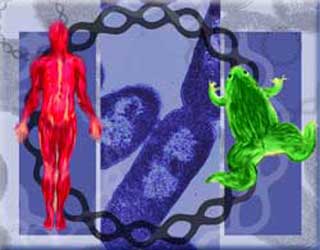Recombinant revolution (human and frog)

The stage was set for a technological revolution. Scientists had figured out how to cut, paste, and copy DNA. What remained to be done, however, was to apply these techniques to actually edit and customize DNA. This creation of "recombinant DNA" would manipulate living things at the most basic level.
recombinant dna,technological revolution,organisms,genes,frog,scientists,customize
- ID: 15639
- Source: DNALC.DNAi
Related Content
15915. The first recombinant DNA
Stanley Cohen and Herbert Boyer's historic experiment used techniques to cut and paste DNA to create the first custom-made organism containing recombined or "recombinant" DNA.
16704. Concept 34: Genes can be moved between species.
Recombinant DNA technology has made it possible to test gene function in bacteria or cell cultures rather than animal models.
15135. Reaction of young scientists to Asilomar, Victor McElheny
Former New York Times journalist Victor McElheny remembers the fears of young scientists.
15030. Implications of recombinant DNA work, Herbert Boyer
Herb Boyer reflects on the importance of their work on rDNA technology and its impact on understanding the genetics of higher organisms.
15641. Charles Best and Frederick Banting
Charles Best (L) and Frederick Banting (R) discovered insulin, 1928.
15653. Asilomar meeting
Asilomar meeting. February 1975. (L to R) Maxine Singer, Norton Zinder, Sydney Brenner, Paul Berg.
16722. Biography 34: Doug Hanahan (1951 - )
Doug Hanahan refined transformation methods for DNA uptake into bacteria.
15422. The need for cutting DNA at specific points, James Watson
James Watson talks about what was needed to read the genetic message.
16755. Biography 36: Thomas Dean Sargent (1953- )
Tom Sargent did some of the first differential gene expression studies using cDNA subtraction.
15021. The moratorium letter regarding risky experiments, Paul Berg
In 1974, scientists in the field of recombinant DNA drafted a letter calling upon "scientists throughout the world" to suspend certain types of studies until hazards could be assessed. Paul Berg talks about the "Moratorium Letter."












